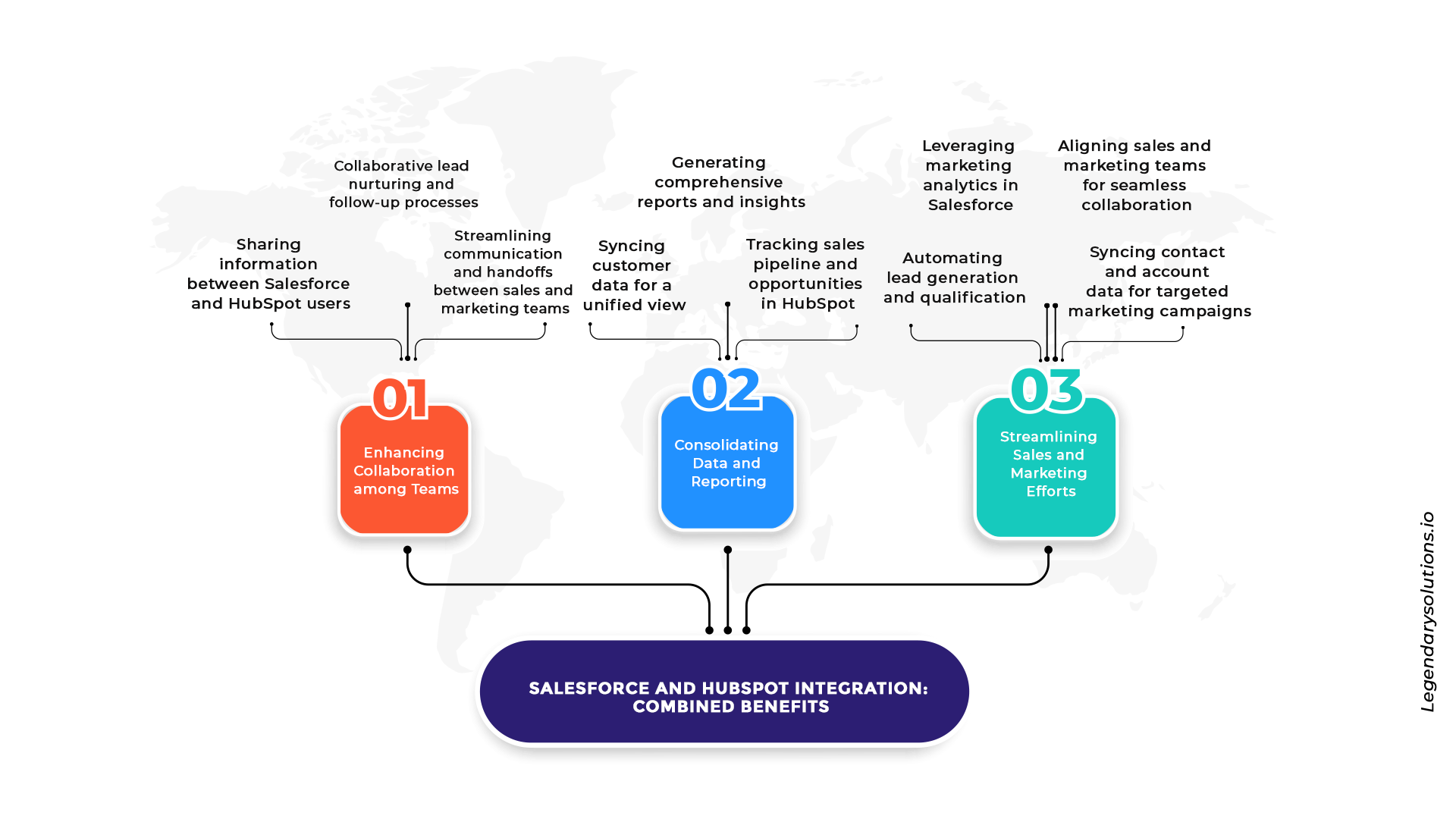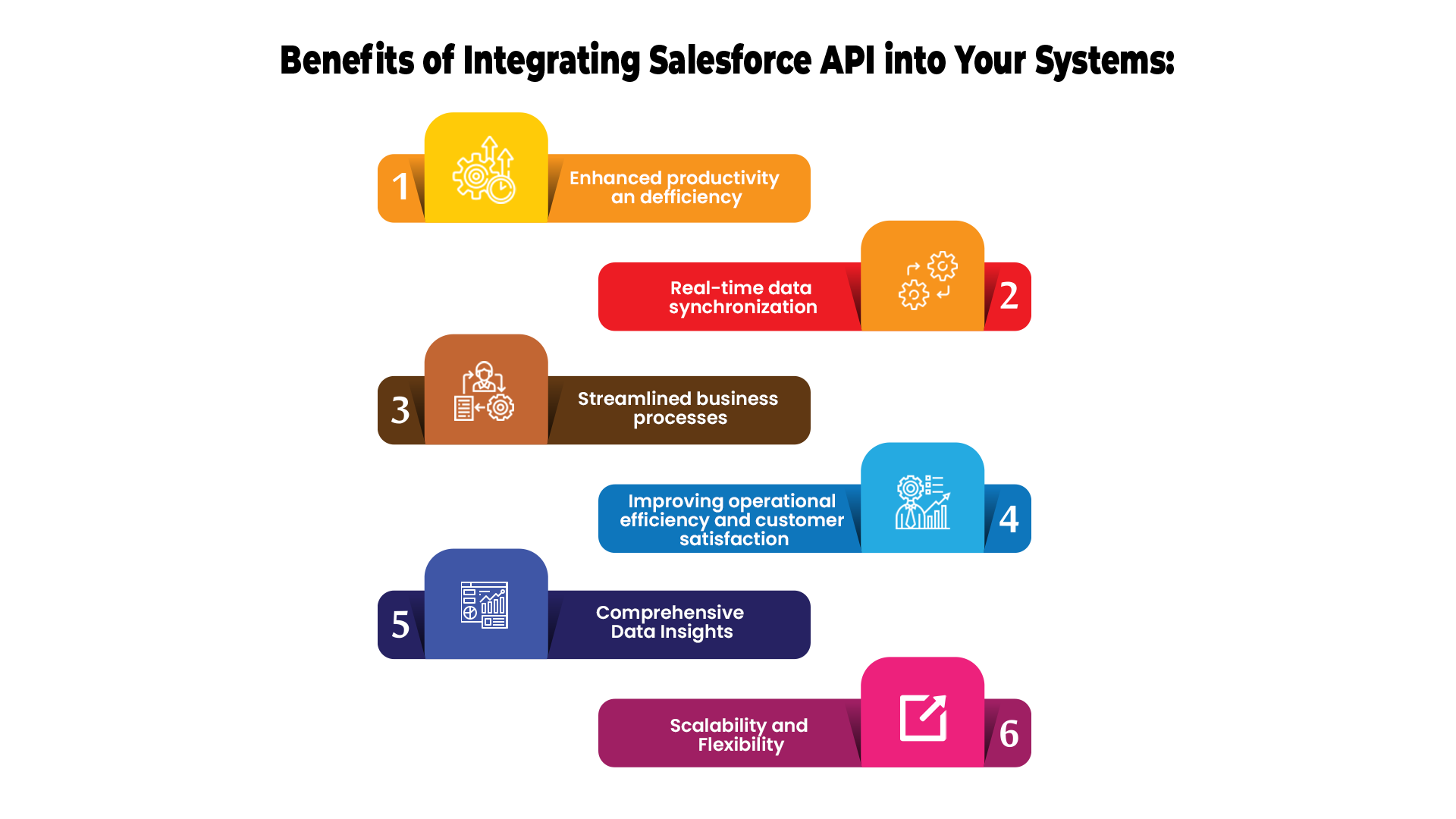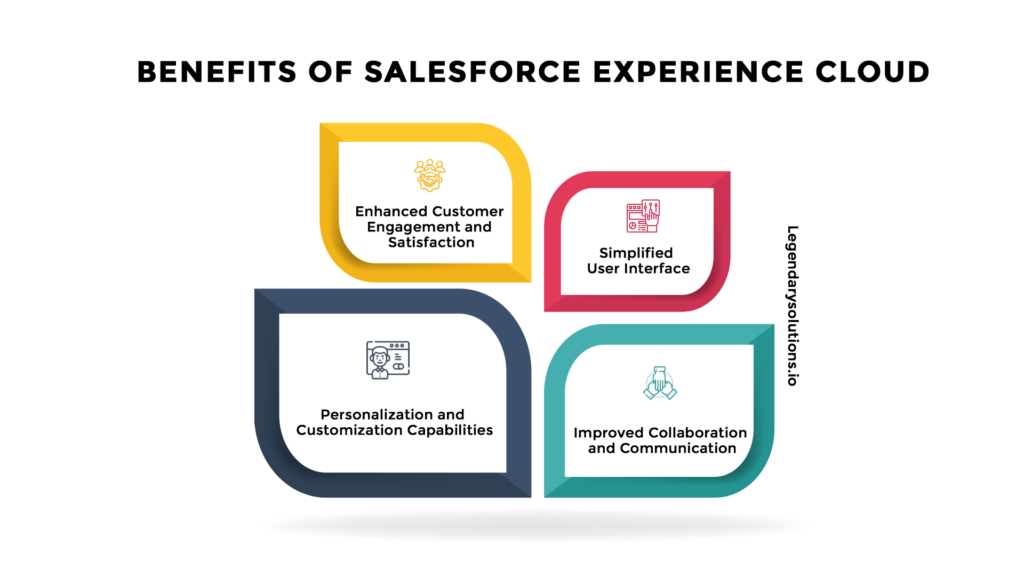Maximizing Efficiency and Collaboration with Salesforce and HubSpot Integration
Posted on Jun 13 , 2023
INTRODUCTION
Salesforce and HubSpot are two powerful platforms that play essential roles in managing customer relationships, sales processes, and marketing efforts.
Salesforce is a top customer relationship management (CRM) technology that helps companies handle leads and opportunities efficiently, track customer interactions, and streamline sales operations.
HubSpot, on the other hand, is a renowned inbound marketing and sales software that empowers businesses to attract, engage, and delight customers with its comprehensive suite of tools.
While Salesforce and HubSpot are robust on their own, integrating these two platforms can unlock a whole new level of efficiency and collaboration for businesses. The integration allows seamless communication and data synchronization between the CRM and marketing systems, enabling sales and marketing teams to work together seamlessly and achieve better results.
The importance of integrating Salesforce and HubSpot cannot be overstated. It eliminates data silos and manual data entry, ensuring that customer information is consistent and up-to-date across both systems. This integration enhances the overall customer experience, as sales and marketing teams have access to complete and accurate data, enabling them to provide personalized interactions and targeted campaigns.
UNDERSTANDING SALESFORCE AND HUBSPOT INTEGRATION
Integration capabilities and features: When it comes to integrating Salesforce and HubSpot, there are huge possibilities. The integration offers a wide range of capabilities and features that enhance the functionality of both platforms. It provides smooth communication and data interchange between HubSpot and Salesforce, doing away with manual data entry and lowering the possibility of mistakes.
Some of the key integration capabilities include bi-directional data synchronization, lead and contact syncing, campaign tracking, and automated data updates. This means that any changes made in Salesforce or HubSpot will automatically reflect in the other system, ensuring data consistency and accuracy.
Additionally, the integration allows for the mapping of custom fields, so businesses can tailor the integration to their specific needs. This flexibility ensures that relevant data from both platforms can be shared and utilized effectively, providing a comprehensive view of customer interactions and behaviors.
Data synchronization between Salesforce and HubSpot: One of the core benefits of integrating Salesforce and HubSpot is the seamless synchronization of data. Customer information, such as leads, contacts, accounts, and opportunities, can be synchronized between the two platforms in real-time. This synchronization ensures that sales and marketing teams have access to the most up-to-date and accurate data, enabling them to make informed decisions and take timely actions.
For example, when a new lead is generated in HubSpot, it can be automatically pushed to Salesforce as a new lead or contact record. Likewise, if a lead is converted into an opportunity in Salesforce, the data can be synced back to HubSpot, allowing marketing teams to track the progress and effectiveness of their campaigns.
SETTING UP SALESFORCE AND HUBSPOT INTEGRATION
Integration’s preconditions: Prior to beginning the integration process, it’s crucial to confirm that a few conditions are satisfied. These consist of having administrator access to both HubSpot and Salesforce as well as active accounts on both systems. It’s also crucial to establish exactly what data you want to sync and what objectives you hope to accomplish through integration. This planning will facilitate setup and maximize the advantages of the integration.
Step-by-step guide to connecting Salesforce and HubSpot: Start by logging into both your Salesforce and HubSpot accounts.
In Salesforce, navigate to the AppExchange and search for the HubSpot integration app. Install the app into your Salesforce instance.
In HubSpot, go to the App Marketplace and locate the Salesforce integration app. Install the app and follow the provided instructions to connect HubSpot with your Salesforce instance.
Once the integration apps are installed in both platforms, go to the Salesforce setup and locate the HubSpot integration settings. Configure the necessary settings, such as specifying which objects and fields should be synchronized between the two platforms.
In HubSpot, access the Salesforce integration settings and configure the mapping of fields between Salesforce and HubSpot. This step ensures that the data is properly aligned and synced
Test the integration by creating test records in both Salesforce and HubSpot and verifying that the data synchronization is working correctly.
Once the integration is set up and tested successfully, communicate the changes and new processes to your sales and marketing teams. Provide them with training and resources to ensure they understand how to utilize the integrated system effectively.
Configuring data mapping and synchronization settings: During the integration setup, configuring data mapping and synchronization settings is crucial to ensure the right data flow between Salesforce and HubSpot. This step allows you to define how different fields in each platform correspond to one another.
In Salesforce, you can map fields such as leads, contacts, accounts, opportunities, and custom objects to their corresponding fields in HubSpot. This mapping ensures that data is accurately synced and shared between the two systems.
Additionally, you can modify synchronization options like data synchronization frequency, one-way or bidirectional data synchronization, and any filters or rules for data synchronization. These options allow you flexibility over how the integration functions based on the requirements and workflows of your company.
STREAMLINING SALES AND MARKETING EFFORTS
Automating lead generation and qualification: Integrating Salesforce and HubSpot enables businesses to automate lead generation and qualification processes, saving valuable time and improving efficiency. With the integration in place, leads captured through HubSpot’s marketing activities can be seamlessly transferred to Salesforce, where they can be assigned to sales representatives for follow-up. This automation eliminates manual data entry and ensures a smooth handoff between marketing and sales teams, accelerating the lead-to-opportunity conversion process.
Moreover, intelligent lead scoring and qualification rules can be set up within HubSpot and synced with Salesforce. This automation allows for the automatic prioritization of leads based on predefined criteria, ensuring that sales reps focus their efforts on the most qualified leads. By automating lead generation and qualification, businesses can increase their sales productivity and improve overall conversion rates.
Syncing contact and account data for targeted marketing campaigns: The integration between Salesforce and HubSpot enables the synchronization of contact and account data, providing a unified view of customers across both platforms.
As a result of this synchronization, sales, and marketing teams are guaranteed access to the most recent data, enabling them to conduct individualized and focused marketing campaigns.
For instance, when a contact’s information is updated in Salesforce, the changes are automatically reflected in HubSpot. Marketing teams can leverage this synchronized data to create highly targeted campaigns, tailoring their messaging and offers based on the latest customer information. This synchronization also helps in segmenting contacts effectively, ensuring that marketing efforts reach the right audience with the right message at the right time.
Leveraging marketing analytics in Salesforce: By integrating HubSpot’s marketing analytics with Salesforce, businesses gain a comprehensive view of their marketing performance and its impact on sales outcomes. HubSpot’s robust analytics capabilities, such as tracking website visits, email engagement, and campaign performance, can be integrated into Salesforce dashboards and reports.
This integration allows businesses to track and measure the effectiveness of marketing campaigns directly within Salesforce. Sales teams can easily access and analyze marketing metrics alongside sales data, providing valuable insights into the success of various marketing initiatives. This alignment of marketing analytics with Salesforce empowers businesses to make data-driven decisions, optimize their marketing strategies, and drive better business outcomes.
Aligning sales and marketing teams for seamless collaboration: Integrating Salesforce and HubSpot fosters collaboration and alignment between sales and marketing teams.
With a single platform, both teams may access shared customer information, allowing them to collaborate easily and benefit from one another’s knowledge.
Sales teams can provide valuable feedback to marketing teams regarding lead quality and campaign effectiveness, helping marketing refine their strategies. Marketing teams, on the other hand, can share insights and campaign results with sales teams, empowering them with actionable data to personalize their sales approach.

CONSOLIDATING DATA AND REPORTING
Syncing customer data for a unified view: Integrating Salesforce and HubSpot allows businesses to consolidate customer data from both platforms, providing a unified view of their interactions and activities.
Salesforce and HubSpot can sync customer data in real time, including contact information, purchase history, conversation logs, and engagement metrics.
In order to provide individualized experiences and targeted campaigns, this synchronization makes sure that the sales and marketing teams have access to a complete and up-to-date client profile.
Whether a customer’s data is updated in Salesforce or HubSpot, the changes are automatically reflected in both systems, eliminating data silos and ensuring consistency across the organization.
Having a unified view of customer data facilitates better decision-making, enables more effective communication, and enhances the overall customer experience.
Tracking sales pipeline and opportunities in HubSpot: Integrating Salesforce and HubSpot empowers businesses to track their sales pipeline and opportunities directly within HubSpot. Sales teams can access and manage their opportunities, track their progress, and update their status—all from within the HubSpot platform.
This integration eliminates the need for sales representatives to switch between different systems, streamlining their workflow and improving productivity. They can conveniently manage their pipeline, update opportunity stages, and collaborate with colleagues without leaving the HubSpot environment.
Tracking sales pipelines and opportunities in HubSpot also allows marketing teams to align their efforts with sales objectives more effectively. They can monitor the impact of marketing campaigns on opportunities and adjust their strategies accordingly, leading to better targeting and higher conversion rates.
Generating comprehensive reports and insights: One of the significant benefits of integrating Salesforce and HubSpot is the ability to generate comprehensive reports and gain valuable insights. The integration allows businesses to combine data from both platforms to create meaningful reports and analyze performance metrics.
Salesforce’s robust reporting capabilities, coupled with HubSpot’s marketing analytics, provide a holistic view of the organization’s sales and marketing activities. Businesses can generate reports on key metrics such as lead generation, conversion rates, revenue attribution, campaign effectiveness, and more.
Businesses may identify areas for improvement, make data-driven decisions, and optimize their sales and marketing efforts thanks to these thorough reports and insights. They can measure the ROI of marketing campaigns, evaluate sales performance, and identify trends and patterns to inform future actions.
By consolidating data and generating comprehensive reports, the integration between Salesforce and HubSpot empowers businesses to gain actionable insights, improve decision-making, and drive continued growth and success.
ENHANCING COLLABORATION AMONG TEAMS
Sharing information between Salesforce and HubSpot users: Integrating Salesforce and HubSpot promotes seamless information sharing between users of both platforms. Teams in sales and marketing can access and share pertinent data, ensuring that everyone has access to the most recent information for their individual jobs.
For example, when a sales representative interacts with a customer in Salesforce, marketing teams using HubSpot can instantly access those interactions and tailor their marketing efforts accordingly. Likewise, marketing teams can provide valuable insights and campaign data to sales representatives, helping them better understand a lead’s engagement history and preferences.
By breaking down information barriers and fostering collaboration between Salesforce and HubSpot users, businesses can facilitate a unified approach to customer engagement and provide a consistent experience throughout the buyer’s journey.
Streamlining communication and handoffs between sales and marketing teams: The integration between Salesforce and HubSpot streamlines communication and handoffs between sales and marketing teams, enabling them to work together seamlessly. It improves efficiency and lowers the possibility of misunderstanding by doing away with the need for time-consuming meetings or manual handoffs to transmit information.
Sales teams can benefit from marketing teams’ insights and data, such as lead scoring, campaign performance, and customer behavior. This information equips sales representatives with valuable context, enabling them to engage leads more effectively and tailor their sales approach.
Conversely, marketing teams can gather feedback and insights from sales teams about lead quality, objections faced, and market trends. This collaboration allows marketing teams to refine their strategies, optimize campaigns, and generate higher-quality leads.
By streamlining communication and handoffs, businesses can foster a culture of collaboration and alignment between sales and marketing teams, ultimately driving revenue growth and improving customer satisfaction.
Collaborative lead nurturing and follow-up processes: The integration of Salesforce and HubSpot empowers sales and marketing teams to collaborate closely in lead nurturing and follow-up processes. Marketing teams can use HubSpot’s robust automation capabilities to nurture leads with personalized content and targeted campaigns.
When a lead reaches a specific stage or meets certain criteria, marketing teams can automatically notify sales representatives in Salesforce, triggering timely follow-up actions. Sales teams can then engage with leads armed with valuable insights from marketing activities, enabling more effective and personalized interactions.
This collaborative lead nurturing process ensures that leads receive consistent messaging and timely attention, increasing the chances of conversion. It also enables sales and marketing teams to align their efforts, maintain a unified approach, and work together towards common goals.
BEST PRACTICES AND TIPS FOR SUCCESSFUL INTEGRATION
Ensuring data integrity and consistency: To maximize efficiency and collaboration with Salesforce and HubSpot integration, it’s crucial to prioritize data integrity and consistency. Establish data governance practices that ensure accurate and reliable data across both platforms.
Regularly review and cleanse data to remove duplicates, inconsistencies, and errors. Implement data validation rules and enforce data quality standards to maintain a high level of data integrity. This will enable teams to rely on accurate information for decision-making and collaboration.
Implementing security measures for data protection: Data security should be a top priority when integrating Salesforce and HubSpot. Implement robust security measures to protect sensitive customer data and prevent unauthorized access.
Ensure both platforms are configured with appropriate access controls, user permissions, and data encryption. Regularly monitor and audit user activities to detect any potential security breaches.
Consider implementing Single Sign-On (SSO) for seamless and secure user authentication across both platforms. This reduces the risk of password-related vulnerabilities and simplifies user management.
Regular maintenance and updates: Maintaining the integration requires regular maintenance and updates. Keep current with Salesforce and HubSpot’s most recent updates, patches, and issue fixes. This ensures that you have access to new features and enhancements while also addressing any potential issues or vulnerabilities.
Regularly review and optimize the integration configuration to align with evolving business requirements and workflows. This may involve adjusting data mappings, synchronization settings, or integration workflows.
Training and support for users: Invest in comprehensive training and support for users to maximize the benefits of the integration. Provide training sessions that cover the basics of Salesforce and HubSpot integration, as well as specific workflows and best practices for collaboration.
Offer ongoing support through documentation, knowledge bases, and help desks to address user questions and issues promptly. Encourage users to share feedback and insights, which can help identify areas for improvement and optimize the integration for better efficiency and collaboration.
CONCLUSION
Businesses looking to increase efficiency and collaboration have a ton of power and potential thanks to the integration of Salesforce and HubSpot. Businesses may connect their sales and marketing initiatives, consolidate data, get useful insights, and improve the entire customer experience by combining the strengths of these platforms.
Teams may collaborate effectively while utilizing common information, automating procedures, and making data-driven decisions thanks to the seamless connectivity. In addition to increasing internal efficiency, this synergy also promotes customer happiness, revenue development, and long-term corporate success.

















